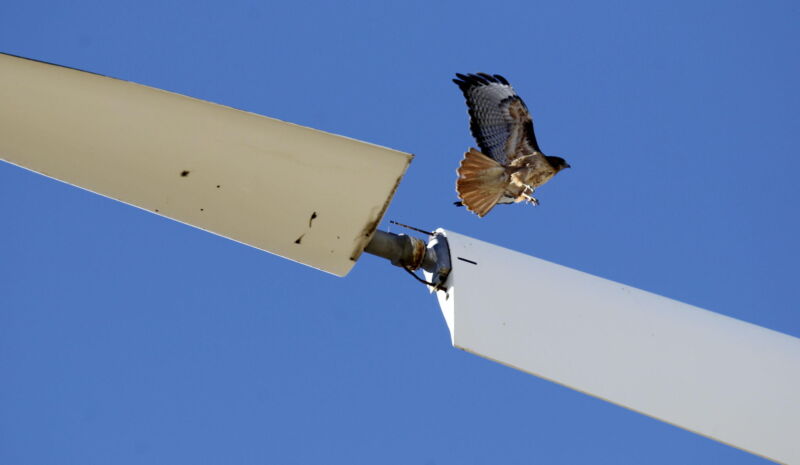

Wanted (by scientists): Dead birds and bats, felled by renewables
source link: https://arstechnica.com/science/2023/01/wanted-by-scientists-dead-birds-and-bats-felled-by-renewables/
Go to the source link to view the article. You can view the picture content, updated content and better typesetting reading experience. If the link is broken, please click the button below to view the snapshot at that time.

Green problems —
Wanted (by scientists): Dead birds and bats, felled by renewables
Collecting, studying, and storing the carcasses, scientists say, can unlock new insights.
Emma Foehringer Merchant, Undark - 1/23/2023, 4:28 PM

"This is one of the least smelly carcasses,” said Todd Katzner, peering over his lab manager’s shoulder as she sliced a bit of flesh from a dead pigeon lying on a steel lab table. The specimens that arrive at this facility in Boise, Idaho, are often long dead, and the bodies smell, he said, like “nothing that you can easily describe, other than yuck.”
A wildlife biologist with the US Geological Survey, a government agency dedicated to environmental science, Katzner watched as his lab manager rooted around for the pigeon’s liver and then placed a glossy maroon piece of it in a small plastic bag labeled with a biohazard symbol. The pigeon is a demonstration specimen, but samples, including flesh and liver, are ordinarily frozen, catalogued, and stored in freezers. The feathers get tucked in paper envelopes and organized in filing boxes; the rest of the carcass is discarded. When needed for research, the stored samples can be processed and sent to other labs that test for toxicants or conduct genetic analysis.
Most of the bird carcasses that arrive at the Boise lab have been shipped from renewable energy facilities, where hundreds of thousands of winged creatures die each year in collisions with turbine blades and other equipment. Clean energy projects are essential for confronting climate change, said Mark Davis, a conservation biologist at the University of Illinois at Urbana-Champaign. But he also emphasized the importance of mitigating their effects on wildlife. “I’m supportive of renewable energy developments. I’m also supportive of doing our best to conserve biodiversity,” Davis said. “And I think the two things can very much coexist.”
To this end, Katzner, Davis, and other biologists are working with the renewable energy industry to create a nationwide repository of dead birds and bats killed at wind and solar facilities. The bodies hold clues about how the animals lived and died, and could help scientists and project operators understand how to reduce the environmental impact of clean energy installations, Davis said.
AdvertisementThe repository needs sustained funding and support from industry partners to supply the specimens. But the collection’s wider potential is vast, Davis added. He, Katzner, and other stakeholders hope the carcasses will offer a wide array of wildlife biologists access to the animal samples they need for their work, and perhaps even provide insights into future scientific questions that researchers haven’t thought yet to ask.
In 1980, California laid the groundwork for one of the world’s first large-scale wind projects when it designated more than 30,000 acres east of San Francisco for wind development, on a stretch of land called the Altamont Pass. Within two decades, companies had installed thousands of wind turbines there. But there was a downside: While the sea breeze made Altamont ideal for wind energy, the area was also well-used by nesting birds. Research suggested they were colliding with the turbines’ rotating blades, leading to hundreds of deaths among red-tailed hawks, kestrels, and golden eagles.
“It’s a great place for a wind farm, but it's also a really bad place for a wind farm,” said Albert Lopez, planning director for Alameda County, where many of the projects are located.
A 2004 report prepared for the state estimated deaths and offered recommendations that the authors said could add up to mortality reductions of anywhere from 20 to 50 percent. The most effective solution, the authors argued, involved replacing Altamont’s many small turbines with fewer larger turbines. But, the authors wrote, many measures to reduce deaths would be experimental, “due to the degree of uncertainty in their likely effectiveness.” More than a decade of research, tensions, and litigation followed, focused on how to reduce fatalities while still producing clean electricity to help California meet its increasingly ambitious climate goals.
While all this was happening, Katzner was earning his PhD by studying eagles and other birds—and beginning to amass a feather collection halfway around the world. In Kazakhstan, where he has returned nearly every summer since 1997 to conduct field research, Katzner noticed piles of feathers underneath the birds’ nests. Carrying information about a bird’s age, sex, diet, and more, they were too valuable a resource to just leave behind, he thought, so he collected them. It was the start of what he describes as a compulsion to store and archive potentially useful scientific material.
Recommend
About Joyk
Aggregate valuable and interesting links.
Joyk means Joy of geeK